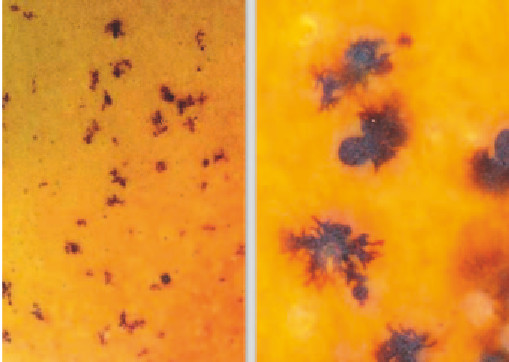Agriculture Reference
In-Depth Information
Management
•
Do not harvest immature fruit.
Remove reject fruit from the packing shed; clean and
sanitise the packing shed and equipment regularly.
•
Handle fruit carefully to avoid damaging the skin.
•
Follow desapping procedures to minimise sapburn.
•
Avoid contact with the ground while bleeding sap from
fruit.
•
DENDRITIC SPOT
■
Cause
Dendritic spot may be caused by more than one species
of fungi. The principal causal agents are thought to be
anamorphs of
Botryosphaeria
spp. (e.g.
Fusicoccum
spp.,
Neofusicoccum
spp.) and
Colletotrichum gloeosporioides
.
Fig 12.22 Early and severe symptoms of dendritic spot.
Symptoms
Symptoms are only expressed when fruit ripen. Small dark
irregularly branched spots 2-5 mm in diameter appear
anywhere on the fruit surface.
Source of infection and spread
Infection appears to occur in the field but little is known
about the disease cycle. Spores of the causal fungi, washed
onto fruit from within the tree, may be a major source
of inoculum.
Importance
Dendritic spot has increased in importance over recent
years and is now considered a major postharvest disease.
Fig 12.23 Severe dendritic spot lesions on ripe mango.
Management
•
Prune trees regularly after harvest to remove all dead
wood and minimise any dead inner branches.
Use fungicide fi eld sprays for controlling anthracnose and
stem-end rot; this may help to reduce inoculum levels in
the orchard.
•
Fig 12.21 Early (left) and severe (right) dendritic spot lesions as they
appear in ripe fruit.













